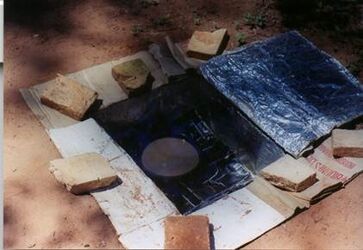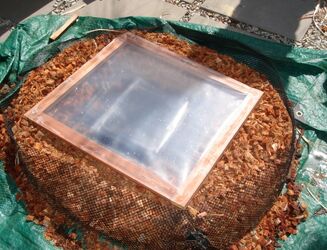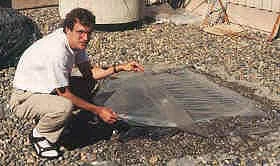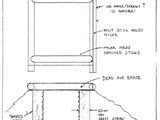In-the-ground solar cooker designs substitute digging a hole in the ground to replace the box container of a typical solar box cooker, or to provide support for the reflectors of a solar panel cooker. This simplifies construction, but the approach has some limitations. If trying to replicate a box cooker, some form of insulation will be required to line the sides and bottom of the hole.
Said Shakerin researched an early design that used only a black insulating mat at the bottom of the hole with a glazing cover and reflector on top. Said has written up his findings here: Earthen Solar Cooker
John Barker has done considerable research with the Solar Nest. He has experimented using netted bags of coconut husks to mimic digging into insulating ground cover. Others, such as Kristen Rahn, have used newspaper for insulating the cooking chamber. Unless a design dug into the ground uses a circular or oversized glazing cover, it is not possible to reorient the reflector while cooking.
The Solar puddle is a water pasteurization technique based upon the research of Dale Andreatta for large amounts of water. It is essentially a puddle of water in a greenhouse being heated to at least 70°C (158°F)
Most of the designs have used the box cooker approach. However, a panel cooker may have possibilities. Staff at Solar Cookers International have considered lining a hole with a mylar reflective 'space' blanket. The material dug from the hole could be built up to create a circular reflector around the hole. Then, typical of a panel cooker, a black pot in a plastic bag on a slightly raised platform, is placed at the center. While it would not be possible to redirect the reflectors, it is conceivable that two holes might be dug side by side, with one cooker directed to morning sun and the other at afternoon sun. A trench dug between the two cookers would also make it easier for the user to easily reach the cook pot. This approach would be particularly useful for locations near the equator. More research should be done with space blankets used as reflectors. They are available commercially for approximately $5 USD.
Soil consistency will also be a factor, as soil too sandy may not support the reflector blanket. Soil type is also a factor for the box style cooker, as unless the walls are supported, the soil may cave-in on the sides.
All items (8)














